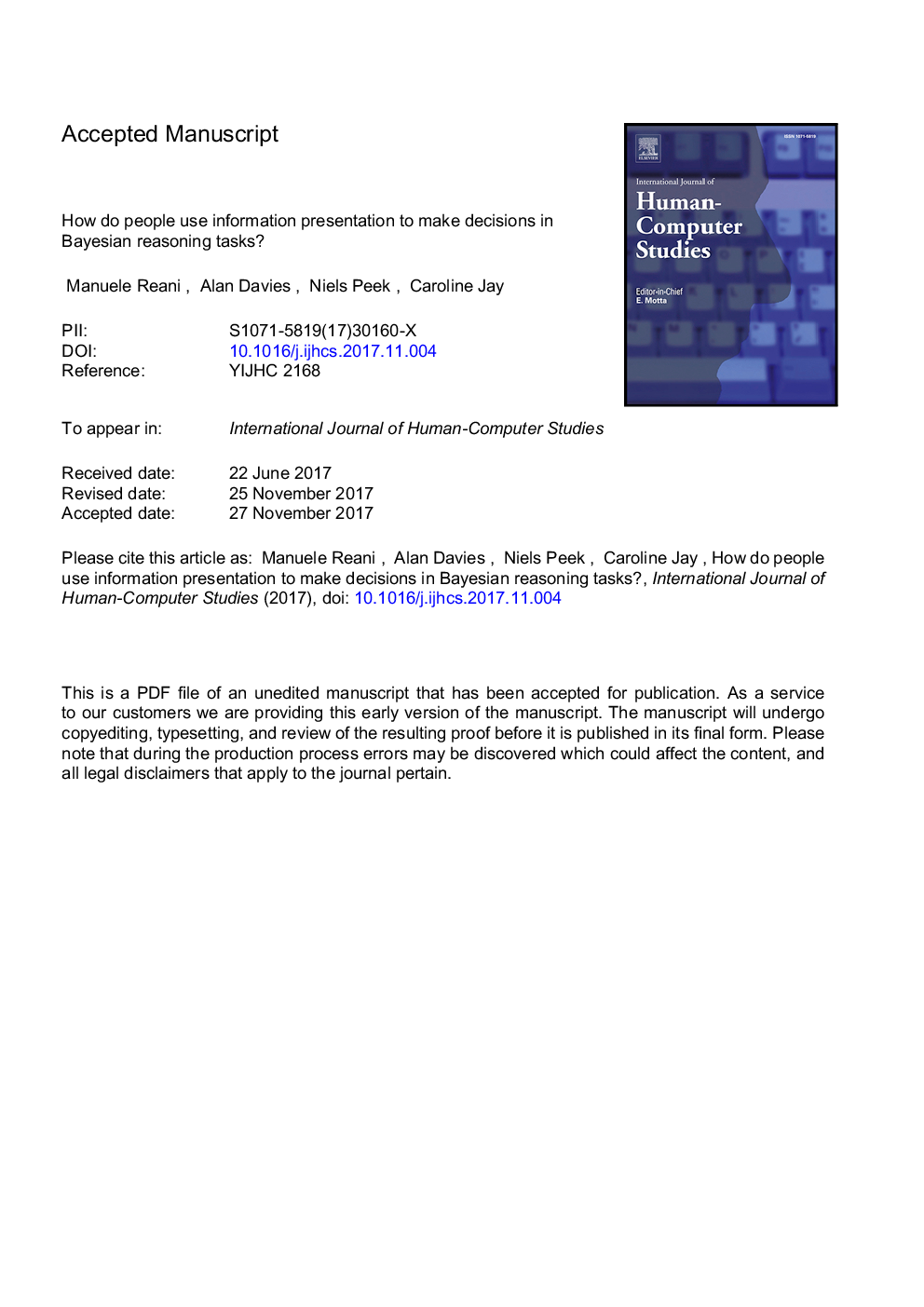| کد مقاله | کد نشریه | سال انتشار | مقاله انگلیسی | نسخه تمام متن |
|---|---|---|---|---|
| 6860990 | 1438943 | 2018 | 46 صفحه PDF | دانلود رایگان |
عنوان انگلیسی مقاله ISI
How do people use information presentation to make decisions in Bayesian reasoning tasks?
ترجمه فارسی عنوان
چگونه مردم از ارائه اطلاعات برای تصمیم گیری در وظایف استدلال بیزی استفاده می کنند؟
دانلود مقاله + سفارش ترجمه
دانلود مقاله ISI انگلیسی
رایگان برای ایرانیان
کلمات کلیدی
تجسم اطلاعات، استدلال بیزی، استدلال احتمالاتی، تجسم داده، داوری، تصمیم سازی، تجزیه و تحلیل ویژوال، ردیابی چشم، آزمایش قابلیت استفاده، تجربه ی کاربر،
usability testing - آزمایش قابلیت استفادهProbabilistic reasoning - استدلال احتمالیBayesian reasoning - استدلال بیزیUser experience - تجربه ی کاربرVisual analytics - تجزیه و تحلیل ویژوالInformation visualisation - تجسم اطلاعاتData visualisation - تجسم دادهDecision making - تصمیم سازیJudgment - داوریEye-tracking - ردیابی چشم
ترجمه چکیده
انسانها اغلب برای درک شرایط احتمالی مشکوک، که تفسیر بسیاری از روشهای مهم از جمله آزمایشات پزشکی را در بر میگیرد، تلاش می کنند. تجسم در ارتباط با خطر در تنظیمات سلامت اثبات شده است، اما نقش آن در تسهیل استدلال بیزی پیچیده است، با شواهد متناقض در مورد کاربرد آن و عدم درک در مورد چگونگی آن بهترین استفاده می شود. این مقاله هر دو تکنیک های مبتنی بر و روش جدید برای تجسم احتمالات شرطی را مورد بررسی قرار می دهد، نه تنها بررسی اینکه آیا آنها درک را آسان می کنند، بلکه چگونه مردم از نحوه ارائه اطلاعات برای تفسیر داده ها استفاده می کنند. ما گزارش یک مطالعه کنترل شده با مقایسه تجربیات مختلف از یک مشکل شناخته شده بیزی، مشکل ماموگرافی، به شرح متنی آن است. ما از ردیابی چشم استفاده می کنیم، همراه با یک روش جدید برای اندازه گیری فرایند استدلال (که ما متریک استفاده استفاده می کنیم)، همراه با اندازه گیری کارایی، کارآیی و رضایت، برای نشان دادن فرآیندهای شناختی که درک فهم انسان را نشان می دهند. نتایج نشان می دهد که نادر بودن یک رویداد به شدت تحت تاثیر قرار می گیرد که برآورد کسینی از ارزش واقعی خطر متفاوت است و رویدادهای نادر که منجر به انحراف بیشتر از رویدادهای معمول می شود. نتایج همچنین نشان می دهد که شیوه ارائه داده ها بر سرعت و دقت تفسیر تأثیر می گذارد و افراد دارای ترجیحات هستند که نمی توانند به تنهایی با داده های عملکرد توضیح داده شوند. در حالی که نمودارهای ون به نظر می رسد برابر با نمودار درخت از لحاظ عملکرد وظیفه، مردم می یابد که دومی را آسان تر به تفسیر. آرایه آیکون، که معمولا برای ارائه اطلاعات ریسک استفاده می شود، در انتقال اطلاعات در مورد احتمالات شرطی بسیار ضعیف است.
موضوعات مرتبط
مهندسی و علوم پایه
مهندسی کامپیوتر
هوش مصنوعی
چکیده انگلیسی
Humans often struggle to understand conditional probability, which underlies the interpretation of many important procedures including medical tests. Visualisation has proved effective in communicating risk in healthcare settings, but its role in facilitating Bayesian reasoning is complex, with contradictory evidence as to its utility, and a lack of understanding as to how it is best applied. This paper evaluates both established and novel techniques for visualising conditional probabilities, examining not just whether they facilitate understanding, but how people use the way the information is presented to interpret the data. We report a controlled study comparing different visualisations of a well-known Bayesian problem, the mammography problem, to its textual description. We use eye tracking, coupled with a novel technique to measure the reasoning process (which we term the utilisation metric), alongside measures of efficiency, effectiveness and satisfaction, to reveal cognitive processes underpinning human-graph understanding. The results demonstrate that the rarity of an event strongly affects how far someone's estimation deviates from the true value of the risk, with rare events resulting in a larger deviation than common events. The results also show that the way in which the data is presented affects both speed and accuracy of interpretation, and that people have preferences that cannot be explained by performance data alone. Whilst Venn diagrams appear to be equal to tree diagrams in terms of task performance, people find the latter easier to interpret. Icon arrays, which are commonly used for presenting risk data, are perceived to be particularly poor at conveying information about conditional probabilities.
ناشر
Database: Elsevier - ScienceDirect (ساینس دایرکت)
Journal: International Journal of Human-Computer Studies - Volume 111, March 2018, Pages 62-77
Journal: International Journal of Human-Computer Studies - Volume 111, March 2018, Pages 62-77
نویسندگان
Manuele Reani, Alan Davies, Niels Peek, Caroline Jay,
